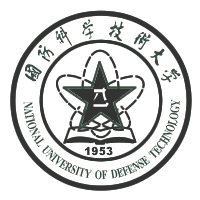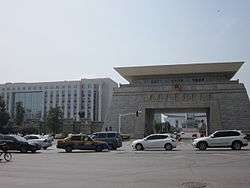National University of Defense Technology
| 国防科学技术大学 | |
 | |
Former names |
Harbin Military Academy of Engineering Changsha Institute of Technology |
|---|---|
| Motto | 厚德博学、强军兴国 |
Motto in English | Excel in Virtue and Knowledge; Strengthen the Armed Forces and the Nation |
| Type |
National Key University Military Academy |
| Established | September 1, 1953 |
| Affiliation | Central Military Commission (China) |
| President | General Yang Xuejun (2012-) |
Academic staff | 2,000 faculty members |
| Students | 15,700 |
| Undergraduates | 8,900 |
| Postgraduates | 6,800 |
| Location | Changsha, Hunan, China |
| Campus | 373 hectares, or 922 acres |
| Website |
www |
| National University of Defense Technology | |||||||
| Simplified Chinese | 国防科学技术大学 | ||||||
|---|---|---|---|---|---|---|---|
| Traditional Chinese | 國防科學技術大學 | ||||||
| |||||||

National University of Defense Technology (NUDT, Chinese: 国防科学技术大学) or People's Liberation Army National University of Defense Science and Technology in full (Chinese: 中国人民解放军国防科学技术大学) is a top military academy, as well as a research type national key university located in Changsha, Hunan Province, China. It is under the direct leadership of China's Central Military Commission, and dual management of Ministry of National Defense of the People's Republic of China and Ministry of Education. It is designated for Project 211 and Project 985, the two national plans for facilitating the development of Chinese higher education. Its authority level equals the Deputy Military Region (see Military regions of the People's Liberation Army).
NUDT was ranked as one of the Top 4 Universities in China, the only 4 universities with a 7-Star status, along with Peking University, Tsinghua University, and University of Chinese Academy of Science, when it was ranked the 2nd time with Chinese civilian universities in year 2015. Since being founded as China's supreme military academy (最高军事工程学院)Harbin Military Academy of Engineering in 1953, the university has been regarded as the indisputable No.1 military academy in China, and a symbol of modern Chinese national defense science and technology. It has produced a great number of outstanding graduates for China, played an important role in major state scientific and technological activities such as the Manned Space Flight Project (see Shenzhou program), and has accomplished a significant number of scientific research achievements, prominently represented by Tianhe Supercomputers (see Tianhe-2).
NUDT has always been at the forefront of China’s national defense research. For fulfilling the demand arising from the strategies of strengthening national defense by means of science and technology, and building an innovative country, NUDT fully utilizes its integrative disciplinary strengths in science, engineering, management, military science, humanities and social sciences, to provide vigorous support for the modernization of the Chinese armed forces, to provide talent and technical support to China’s national economy and social development, and, ultimately, to make contributions to world peace and development.
NUDT is a leading institute in the Chinese space program and China's Supercomputer development (see Supercomputing in China).
As one of the most difficult universities to enter in China, NUDT admits freshly graduated high school students into its undergraduate programs through the rigorous Chinese National Higher Education Entrance Examination. This is different from PLA National Defence University that generally admits current army personnel from their military posts into its programs.
History
NUDT was founded on September 1, 1953 as the People's Liberation Army (PLA) Military Academy of Engineering (Chinese: 中国人民解放军军事工程学院) or Harbin Military Academy of Engineering (Chinese: 哈尔滨军事工程学院) under the direct leadership of the Chinese Central Military Commission. Grand General Chen Geng (Chinese: 陈赓) (similar to a Five-Star general in the U.S., see Five-star rank) was appointed the first President. It was located in Harbin, Heilongjiang Province, in Northeastern China, close to the boarder with the former Soviet Union.
The university was founded as the supreme military academy of China. It had five departments and one prep-department at the time of its founding, including departments of Air Force Engineering, Artillery Engineering, Naval Engineering, Armoring Force Engineering, and Corps of Engineers. Departments of Chemical Warfare and Nuclear Warfare were later established in the university.
During the Cultural Revolution, the university was transitioned to the Committee of National Defense Science and Technology, and was renamed Harbin Academy of Engineering in 1966. In 1970, the main body of the university including its central administration and 4 departments moved to Changsha in South-Central China due to the possible war with the Soviet Union, and was renamed Changsha Institute of Technology. Other departments were converted to at least five independent national universities, or taken by other national universities or science research institute. The university's name was changed to People's Liberation Army National University of Defense Science and Technology in 1978 after the Cultural Revolution was over.
Campus
NUDT is located in the urban area of Changsha, capital of Hunan Province in South-Central China, covering a total area of 373 hectares, or 922 acres.
Administration
- President: General YANG Xuejun, Fellow of Chinese Academy of Science
- Political Commissar: General WANG Jianwei
Academics
Over the past 60 years NUDT has developed into a comprehensive university of science, engineering, military science, management, economics, philosophy, literature, education, law and history. The university consists of 10 colleges administering over 40 departments, institutes and laboratories, four national key laboratories and one key laboratory at the Ministry of Education level. NUDT plays a leading role in many subjects, nine of which are national key subjects. According to the National First-Category Discipline Evaluation from the years 2002-2004 organized by the Ministry of Education, five disciplines of NUDT made the ‘top five’ list and the discipline of Computer Science and Technology ranked first nationwide.
The 10 colleges of the university include:
- College of Aerospace Science and Engineering
- College of Science
- College of Mechatronic Engineering and Automation
- College of Electronic Science and Engineering
- College of Information System and Management
- College of Computer
- College of OptoElectronic Science and Engineering
- College of Humanities and Social Science
- College of Basic Education
- College of Continuing Education
Statistics
Currently, NUDT has over 2,000 faculty members, over 300 of whom are professors. There are 14,000 full-time students including 8,400 undergraduates and 5,600 graduates. NUDT offers 25 subjects for undergraduates, 112 programs for master's degree candidates, and 69 programs for PhD candidates. 11 post-doctoral research stations have been authorized on campus.
Ranking
The university was founded as the supreme military academy of China, and has been regarded as the No.1 military academy in China, since being founded as Harbin Military Academy of Engineering in 1953. It has been called the Military Tshinghua and Chinese West Point in China. It was the only military academy in the world that housed all army disciplines in one military academy, and the largest military academy in Asia, before its relocation during the Chinese Culture Revolution and the Cold War era.
NUDT has not been ranked with civilian universities historically, due to the lack of relevant and reliable public data about the university because of its military and national defense nature. In 2014 when NUDT was ranked the first time with Chinese civilian universities by the Chinese Universities Alumni Association, it was ranked as one of the Top-6 Universities, with a 6-Star status (no 7-star was given to any university), along with Peking University, Tsinghua University, among others. In 2015, NUDT was ranked the second time with Chinese civilian universities, and was ranked as one of the Top-4 universities, with a 7-Star status (when 7-Star was introduced the first time), along with Peking University, Tsinghua University, and University of Chinese Academy of Science, universities widely known by the international community. Universities in this cluster are consistently called the "Top Notch Universities" (顶尖大学), and considered the highest ranking universities in China.
NUDT supercomputers
- Yinhe-I (YH-I)
Yinhe-1 was developed in 1983 as the leading supercomputer in China with a performance level of 100 MFLOPS.
- Yinhe-II (YH-II)
Yinhe-II was built in 1992 achieving performance of 1 GFLOPS.
- Yinhe-III
Yinhe-II was upgraded to Yinhe-III in 1996 which achieves 13 GFLOPS.[1][2]
- Tianhe-I
Tianhe-I was first revealed to the public on 29 October 2009, and was immediately ranked as the world's fifth fastest supercomputer in the TOP500 list released at the 2009 Supercomputing Conference (SC09) held in Portland, Oregon, on 16 November 2009.
- Tianhe-IA
In October 2010, Tianhe-IA, an upgraded supercomputer achieving a performance level of 2.57 PFLOPS,[3] was unveiled at HPC 2010 China and ranked as the world’s fastest supercomputer in the TOP500 list.[4] [5]
In November 2011, the Tianhe-1A ranked as the second fastest supercomputer in the world on TOP500 after it was surpassed by K Computer by Fujitsu of Japan.
- Tianhe-2
Tianhe-2 is currently ranked as the world's second fastest supercomputer on the TOP500 list, having achieved a performance level of 33.86 PFLOPS on 16 June 2013.[6] It was the fastest supercomputer in the world until 2016, when it was surpassed by Sunway TaihuLight at the Chinese National Supercomputing Center.[7]
See also
References
- ↑ "China's Indigenous Supercomputer Development". nti.org. January 1996. Archived from the original on 2011-06-04.
- ↑ Michael Pecht, China's Electronics Industry: The Definitive Guide for Companies and Policy Makers with Interest in China, 2006, ISBN 978-0-8155-1536-4, chapter 3.7.4 China's Supercomputers, page 66
- ↑ "China Wrests Supercomputer Title From U.S." (Press release). New York Times. 28 October 2010.
- ↑ "China Grabs Supercomputing Leadership Spot in Latest Ranking of World’s Top 500 Supercomputers" (Press release). TOP500. 11 November 2010.
- ↑ "Chinese supercomputer ranked world's fastest by TOP500" (Press release). Peopledaily.com.cn. 17 November 2010.
- ↑ Davey Alba (June 17, 2013). "China's Tianhe-2 Caps Top 10 Supercomputers". IEEE Spectrum. Retrieved 19 June 2013.
- ↑ "China builds world's most powerful computer". BBC News. 2016-06-20. Retrieved 2016-06-20.
External links
| Wikimedia Commons has media related to National University of Defense Technology. |
- National University of Defense Technology official website (in Chinese)
- National University of Defense Technology official website (in English)
- China's Supercomputer Fastest in the World (in English)
- Fear Not China’s Supercomputer (in English)
- 2016中国大学排行榜, 国防科大跻身7星级大学 (in Chinese)
